How GPT-5 Thinking Mode Turns Complex Research Into Perfect Claude Code Prompts
I just discovered a workflow that completely changed how I approach complex integrations with Claude Code.
It started with a simple question:
“How do I use Reddit’s API without OAuth2?”
It ended with GPT-5 generating the most comprehensive, project-aware Claude Code prompt I’ve ever seen.
Let me show you how this works, because once you see it, you’ll never write Claude Code prompts the same way again.
.
.
.
The Problem: Complex APIs Need Complex Context
Here’s the typical journey when you need to integrate something like Reddit’s API:
- Google “Reddit API tutorial”
- Find 17 conflicting blog posts
- Realize you need OAuth2
- Find another 23 tutorials on OAuth2
- Try to piece together how it works
- Attempt to explain it to Claude Code
- Get something that “works” but probably has security holes
- Debug for hours
The real problem isn’t Claude Code’s ability to implement – it’s that we don’t give it enough context.
We say “add Reddit login” when we should be providing:
- Complete OAuth2 flow understanding
- Security considerations
- Token refresh strategies
- Error handling patterns
- Integration with existing code patterns
But who has time to research and document all that?
GPT-5 does.
.
.
.
Enter GPT-5’s Thinking Mode
GPT-5’s thinking mode isn’t just about reasoning – it’s about deep research, synthesis, and transformation.
Here’s what happened when I asked it about Reddit’s API:
Me: “Find out how to use Reddit API without going through oauth2”
GPT-5: Proceeds to create ASCII art diagrams explaining why OAuth2 is actually necessary
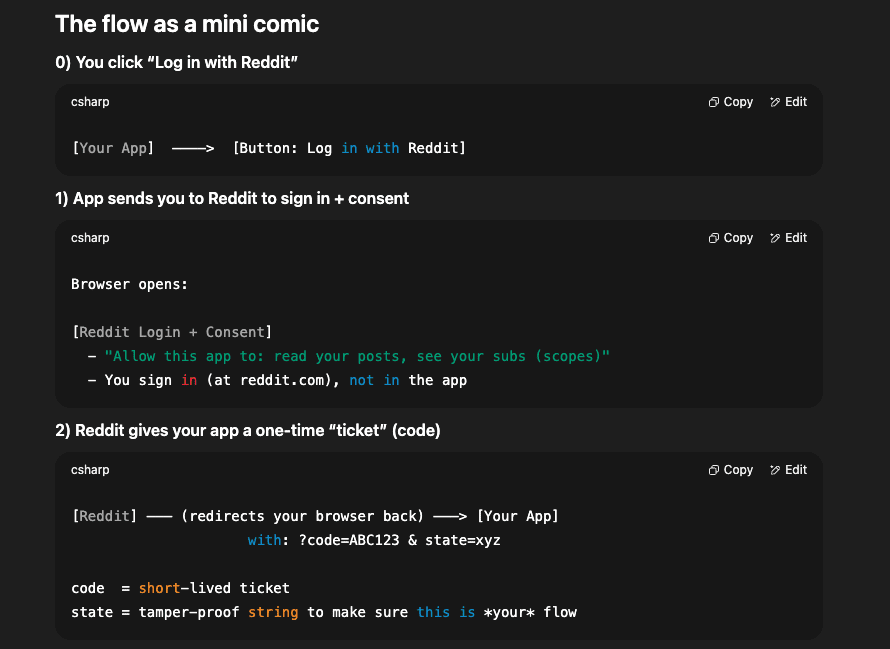
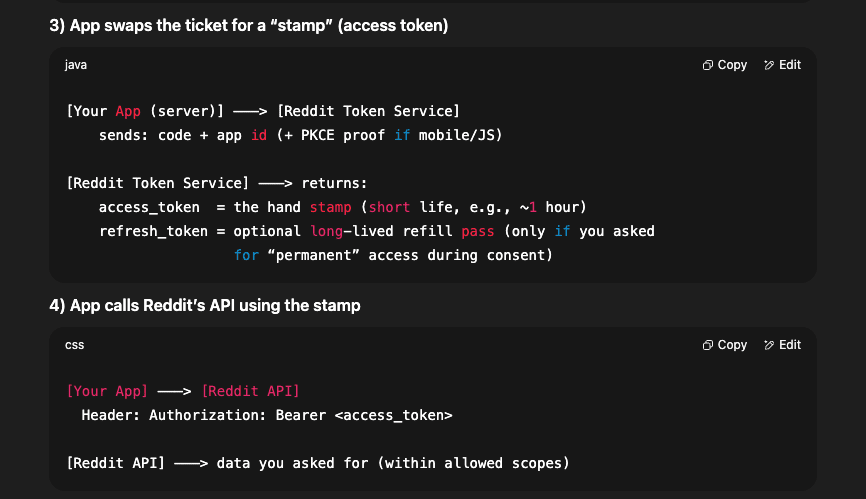
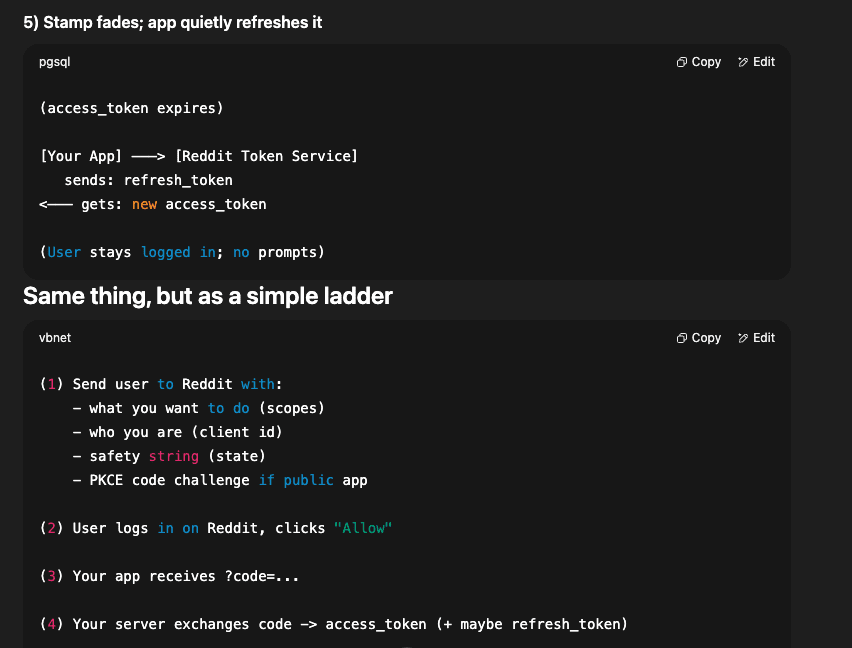
Not only did it explain why I needed OAuth2, it made it understandable with visual analogies.
But here’s where it gets interesting…
.
.
.
From Research to Implementation Guide
Me: “Can you write a full guide with code implementation on how to implement this. My app is based on Next.js 15”

What happened next was remarkable.
GPT-5 didn’t just write generic OAuth2 code. It:
- Researched Reddit’s specific requirements
- Exact endpoints (
oauth.reddit.comnotwww.reddit.com) - Required headers (User-Agent format)
- Rate limits (100 QPM per client)
- Token refresh patterns
- Exact endpoints (
- Considered Next.js 15 architecture
- App Router patterns
- Server-side token exchange
- httpOnly cookies for security
- Proper runtime configurations
- Created production-ready code
- Complete file structure
- Security best practices
- Error handling
- Token refresh logic
- Revocation on logout
The guide was 200+ lines of implementation-ready code with explanations for every decision.
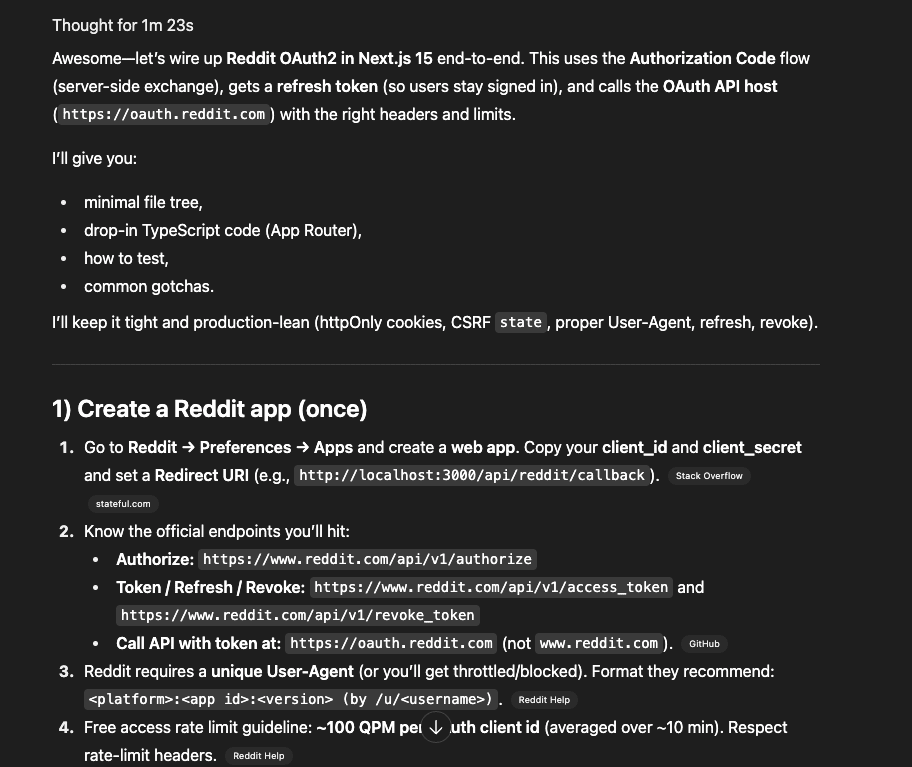
.
.
.
The Magic Moment: Transforming Research Into Claude Code Prompts
This is where things got really powerful.
I showed GPT-5 my standard Claude Code improvement prompt:
# Step 1: Run the following command to understand the current state of the project:
eza . --tree -git-ignore --ignore-glob="node_modules|.git|tmp|.claude|dist|.next|notes"
# Step 2: Review the project rules:
- @notes/rules.md
# Step 3: Review the current codebase and analyze the following improvement items:
Think hard, analyze the existing codebase, and the following improvement items:
{{_IMPROVEMENTS_}}
# Step 4: Create a plan to address the identified improvement items:
- List out everything that needs to be done to implement the improvements in a todos list.
- For each item in the todos list, create a sub-agent to address it. The sub agent should analyze the existing codebase, understand the requirements, and implement the task assigned to it. The sub agent can use web search to find solutions to problems it encounters.
- Once the sub-agent has completed its task, it should report back with the results and any issues encountered. You can then review the results and decide whether to proceed with the next item in the todos list or make adjustments as needed.
And asked: “Help me incorporate the guide into this prompt”
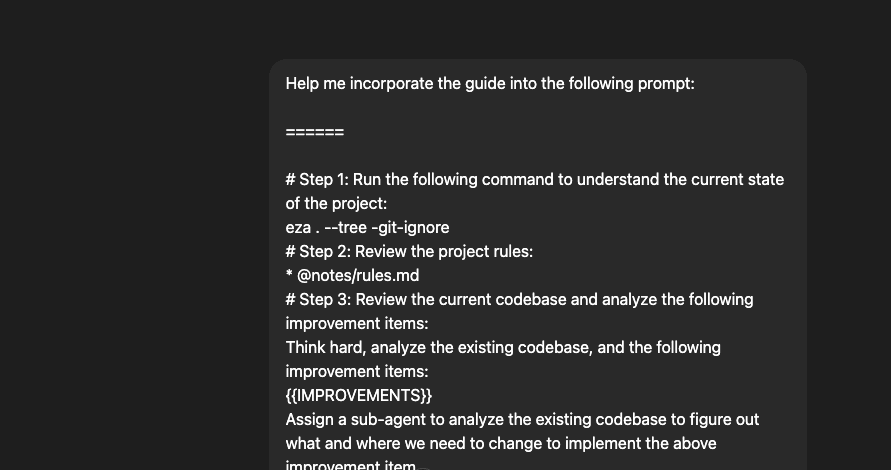
.
.
.
Join The Art of Vibe Coding—short, practical emails on shipping with AI (without the chaos).
No spam. Unsubscribe anytime. Seriously.
Want techniques like these weekly?
What GPT-5 Did Was Brilliant
Instead of just dumping the OAuth2 guide into my prompt template, GPT-5:
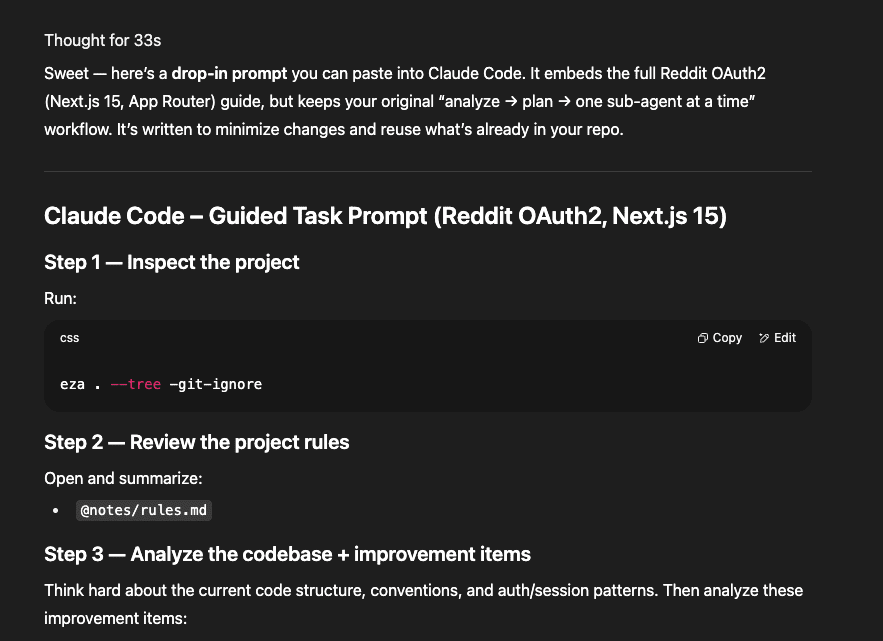
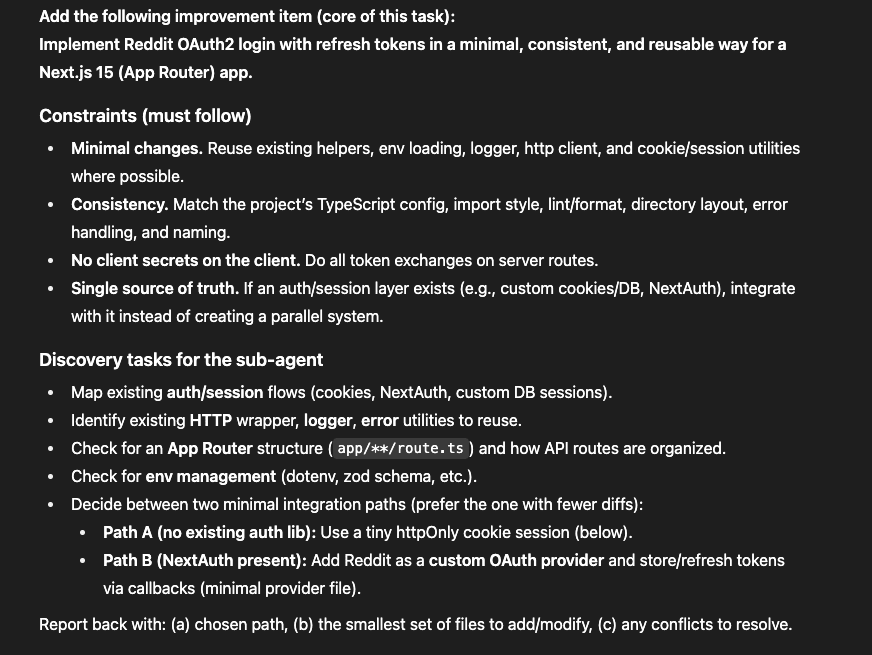

1. Preserved My Workflow Structure
It kept my exact step-by-step approach:
- Inspect project structure
- Review project rules
- Analyze improvements
- Create sub-agent tasks
2. Added Context-Aware Constraints
### Constraints (must follow) * **Minimal changes.** Reuse existing helpers, env loading, logger, http client, and cookie/session utilities where possible. * **Consistency.** Match the project's TypeScript config, import style, lint/format, directory layout, error handling, and naming. * **No client secrets on the client.** Do all token exchanges on server routes. * **Single source of truth.** If an auth/session layer exists (e.g., custom cookies/DB, NextAuth), integrate with it instead of creating a parallel system.
These weren’t generic OAuth2 rules – they were specific to integrating with an existing Next.js codebase.
3. Created Discovery Tasks
Instead of assuming the project structure, it added intelligence gathering:
### Discovery tasks for the sub-agent * Map existing **auth/session** flows (cookies, NextAuth, custom DB sessions). * Identify existing **HTTP** wrapper, **logger**, **error** utilities to reuse. * Check for an **App Router** structure and how API routes are organized. * Decide between two minimal integration paths: * **Path A (no existing auth lib):** Use a tiny httpOnly cookie session * **Path B (NextAuth present):** Add Reddit as a custom OAuth provider
4. Embedded the Complete Implementation
The entire OAuth2 implementation guide was reformatted as reference code that Claude Code could adapt based on what it discovered in the existing codebase.
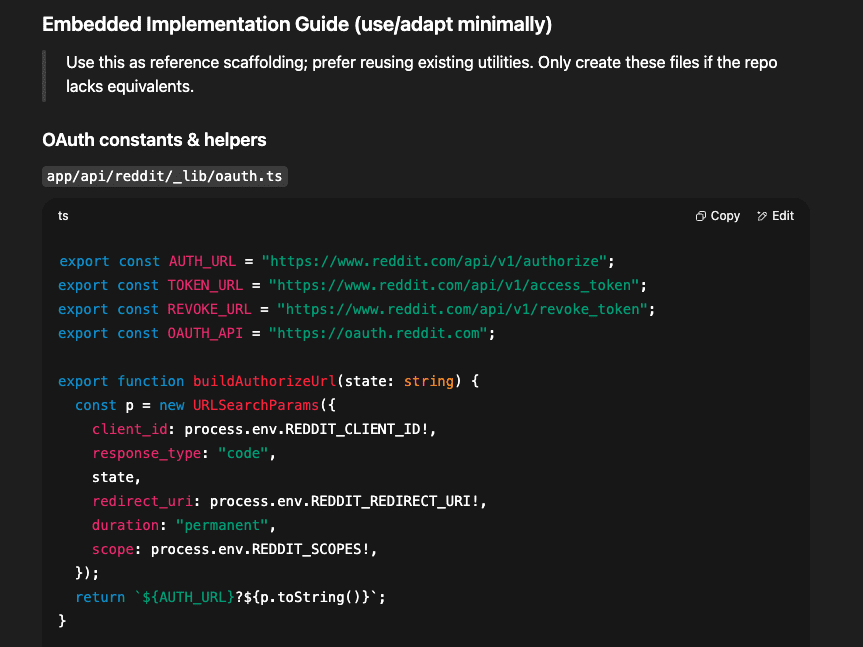

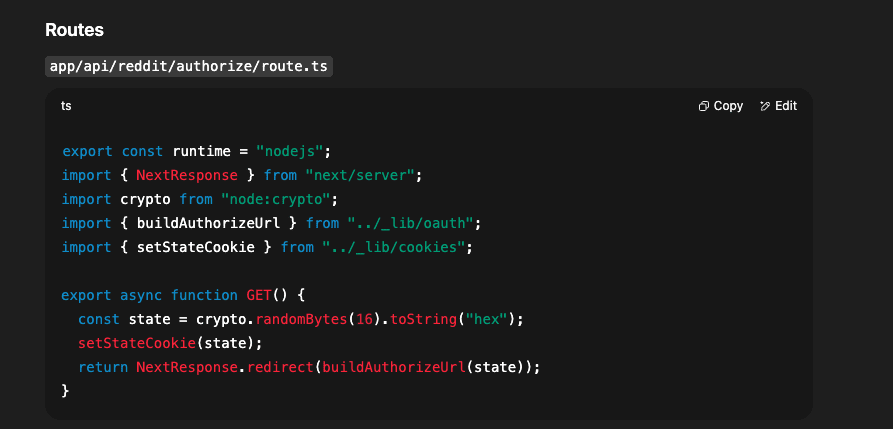
5. Maintained My Sub-Agent Pattern
It structured the todos to work with my one-sub-agent-at-a-time approach:

.
.
.
The Result: A Perfect Claude Code Prompt
The final prompt was 400+ lines of:
- Clear objectives
- Discovery instructions
- Conditional implementation paths
- Complete reference code
- Integration patterns
- Testing checklist
All tailored to work with my existing project structure and patterns.
When I fed this to Claude Code, it:
- Analyzed my existing auth setup
- Chose the appropriate integration path
- Reused my existing utilities
- Implemented only what was needed
- Maintained consistency with my codebase
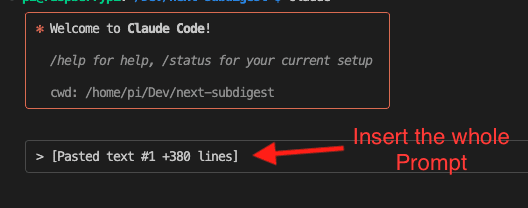

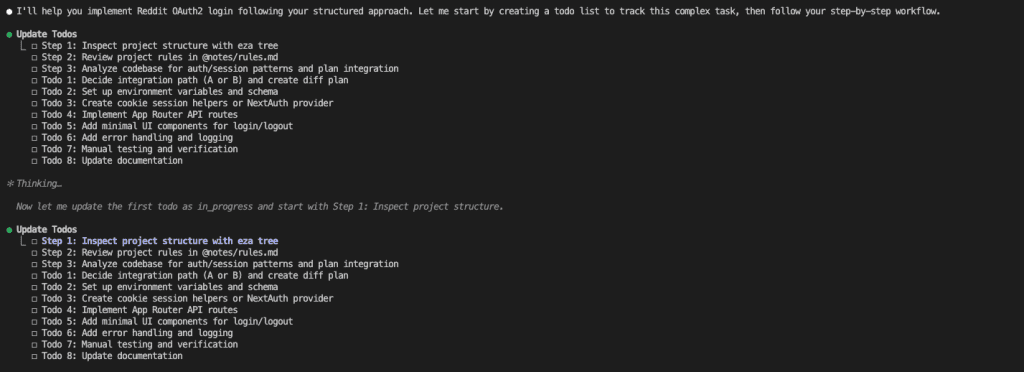

Zero back-and-forth. It just worked.
.
.
.
Why This Changes Everything
This workflow solves the fundamental problem of Claude Code prompts: lack of comprehensive context.
Instead of:
You: “Add Reddit login”
Claude: Makes assumptions, possibly wrong implementation
You: “No, not like that…”
Claude: Different assumptions
[Repeat 10x]
You get:
You: [Comprehensive prompt generated by GPT-5]
Claude: Analyzes, plans, implements correctly
Done.
.
.
.
The GPT-5 + Claude Code Workflow
Here’s the workflow I now use for any complex integration:
Step 1: Research with GPT-5
"I need to integrate [X] into my Next.js app. Research the best practices, security concerns, and implementation patterns."
GPT-5 will:
- Search current documentation
- Understand the technology deeply
- Create visual explanations
- Provide implementation guides
Step 2: Request Implementation Guide
"Write a comprehensive implementation guide for [X] in Next.js 15 with App Router, TypeScript, and production best practices"
GPT-5 creates complete, working code with explanations.
Step 3: Transform into Claude Code Prompt
"Here's my Claude Code prompt template: [template] Incorporate the implementation guide while: - Preserving my workflow structure - Adding discovery tasks to understand existing code - Creating conditional paths based on what exists - Maintaining focus on minimal changes"
GPT-5 transforms the guide into a perfect Claude Code prompt.
Step 4: Execute with Claude Code
Feed the generated prompt to Claude Code and watch it implement everything correctly, respecting your existing patterns.
.
.
.
Pro Tips for Maximum Effectiveness
Tip 1: Be Specific About Your Stack
Tell GPT-5 exactly what you’re using:
- Framework version (Next.js 15, not just Next.js)
- Router type (App Router vs Pages)
- Language preferences (TypeScript vs JavaScript)
- Existing libraries (NextAuth, Prisma, etc.)
Tip 2: Ask for Alternatives
"Research [X] and provide 2-3 implementation approaches with trade-offs for each"
GPT-5 will research multiple solutions and help you choose.
Tip 3: Request Discovery Tasks
Always ask GPT-5 to add discovery tasks to the prompt:
"Add discovery tasks to check what already exists before implementing"
This prevents Claude Code from duplicating existing functionality.
Tip 4: Emphasize Minimal Changes
"The prompt should emphasize reusing existing patterns and making minimal changes"
This keeps your codebase consistent and maintainable.
.
.
.
The Hidden Superpower: Learning by Prompting
Here’s an unexpected benefit:
You learn more from reading GPT-5’s research and transformations than from any tutorial.
When GPT-5 explained OAuth2 with ASCII art:
- I finally understood the flow
- The security reasons became clear
- The implementation made sense
When it transformed the guide into a Claude Code prompt:
- I saw how to structure complex requirements
- I learned conditional implementation patterns
- I understood integration decision trees
You’re not just getting better code – you’re becoming a better developer.
.
.
.
Your Next Complex Integration
Think about that complex integration you’ve been putting off:
- Payment processing?
- Authentication system?
- Third-party API?
- Real-time features?
Now imagine:
- GPT-5 researching everything for you
- Creating a comprehensive guide
- Transforming it into a perfect Claude Code prompt
- Claude implementing it correctly the first time
Stop writing vague prompts and hoping Claude figures it out.
Start using GPT-5 to create comprehensive, context-aware prompts that work.
What complex integration will you tackle with this workflow?
P.S. – The Reddit OAuth2 integration that would have taken me days of research and trial-and-error? Implemented perfectly in 30 minutes. GPT-5 research + Claude Code implementation = the ultimate dev workflow. Try it and watch your productivity explode.
Leave a Comment